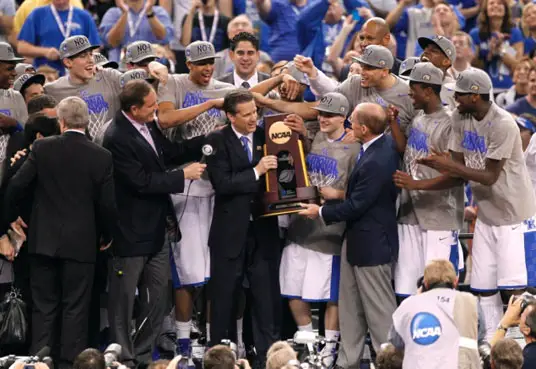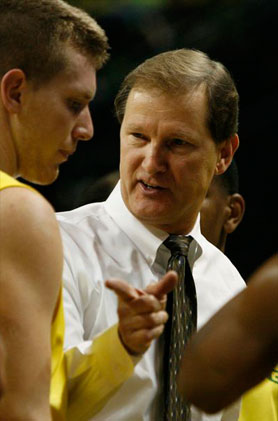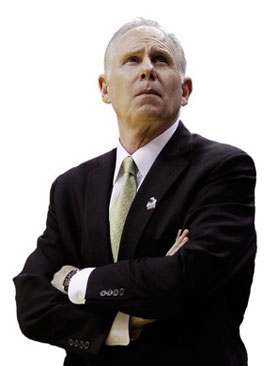For college basketball purists; those who care about balance and building programs, the end of the 2011-12 college basketball season was the sport’s absolute nadir. The Kentucky Wildcats were national champions, despite being a team assembled in the mode of all recent teams under head coach John Calipari: a collection of high school stars whose featured players first played as a unit just six months prior to the NCAA tournament, and the majority of whom won’t play another game for their school afterwards.
Historically, Calipari’s recruiting strategy had been perceived as mostly harmless, with his collection of one-and-dones who were more focused on draft position than collegiate success. Calipari was viewed as being more akin to Rick Barnes than Mike Krzyzewski, focusing on developing players for the pros rather than for that season. Many assumed the furthest eventuality of his strategy would be the 2008 National Championship, when Calipari’s Memphis team, led by Derrick Rose, failed to close the game, allowing Kansas’ Mario Chalmers to hit his famous game-tying three, allowing the Jayhawks to prevail in overtime.
There were programs like those run by Calipari and Barnes that were factories for future pros, and there were programs, like Duke or Michigan State, where players went to if their primary goal was to win championships. Programs could try to achieve both goals, but they were generally designated as one or the other.
As Chuck Klosterman presciently wrote for Grantland last year, once Kentucky won a title, it would signal a shift that could ruin the competitive balance of college basketball, writing,
“If Kentucky is simultaneously the most straightforward finishing school for future professionals and the best place to win a national championship, there’s no reason for a blue-chip high school senior to go anywhere else.”
Kentucky, whose 2012 recruiting class followed the same doctrine, added four freshmen likely to be first-round selections in this June’s NBA draft, and the singular dominance of that program and college basketball’s elite was meant to begin its ruination of college basketball this year. Instead, Kentucky is currently predicted to miss the tournament entirely, while recent champions like North Carolina and Connecticut are sitting outside the Top 25. The 2013 NCAA Tournament is going to be the most wide-open in years.
I have to admit that I didn’t pay much attention to college basketball earlier in the season; Kentucky’s championship had soured me on the sport. I had a hard time justifying following a sport that allowed a coach, who bounced from program to program and left each place in NCAA-sanctioned shambles, to not only succeed, but be praised for winning with an squadron of freshmen mercenaries. Why be interested, if the worst example of a college coach is served up as the image of the sport’s success? Yet two developments made it easy to reinvest in this college basketball season:
1) The parity of college basketball, which has seen a revolving door at number #1; including Gonzaga, who became just the fifth school outside a power six conference to reach #1 in the last twenty years.
2) The emergence of the Ducks. Oregon won its first seven conference games for the first time since the 1925-26, the year before McArthur Court opened, and despite last night’s disappointing result, can still win a share of the Pac-12 regular season title with a win at Utah on Saturday.
Head coach Dana Altman deserves much of the credit for keeping Oregon on top of the Pac-12 standings all season. He has meshed a roster of transfers, talented freshmen, and players held over from the previous staff, and gotten it to largely overachieve; doing so while overcoming injury to his most dynamic player, Dominic Artis, in the middle of conference play.
Altman’s a shoo-in to win Pac-12 Coach of the Year, but how does he stack up on a national level in a year when there are plenty of outstanding coaching performances? Georgetown’s John Thompson III, Marquette’s Buzz Williams, and New Mexico’s Steve Alford are all names that have buzz (no pun intended), but all three led their teams to the NCAA tournament last season. Kansas State’s Bruce Weber and Saint Louis’ Jim Crews have done terrific jobs – Crews in particular has been spectacular, having the Billikens atop the Atlantic 10, despite his interim role following the death of previous coach Rick Majerus in December.
The achievements of all those notwithstanding, only two coaches are in position to win a power six conference after missing the NCAA Tournament last season: Altman, and Miami’s Jim Larranaga. Larranaga’s resume this season makes a strong case: an ACC regular season championship, a Top-10 ranking for the second half of the season, and the last power six conference team to lose a conference game.
What makes the comparison between the coaches so fascinating are their similarities. Each one was a long-time coach at an established mid-major program, who could have retired with their respective schools. Yet two years ago, both took on the challenge of rebuilding a program without a significant basketball history in a major conference. Should Oregon beat Utah on Saturday, two of the six major conference regular season champions won’t be the dynastic, powerhouse programs that regularly win those conferences year-in and year-out, but will instead be schools with coaches who took a chance and built their respective programs to be members of their conference’s elite. The case for national Coach of the Year is strong for either.
Yet no matter who wins, Altman and Larranaga have done something far more important than any award: Other programs can look at what they have done, and dream that they can do the same. They can look at Miami and Oregon, and realize that hope has returned to college basketball.
Related Articles:
Chip Kelly Update: Everything's Good Again ...
Chip Kelly Update: Wailing and Gnashing of Teeth
Shock and Awe -- The Oregon Ducks' Football Hangover Effect
Despite Lopsided Score, Georgia State "Never Stopped Believing"
Hope Springs Eternal for Ducks
Incompetent Pac-12 Officials: How Do You Miss ALL of THIS?
Nathan Roholt is a senior writer and managing editor emeritus for FishDuck. Follow him on Twitter @nathanroholt. Send questions/feedback/hatemail to nroholtfd@gmail.com.



